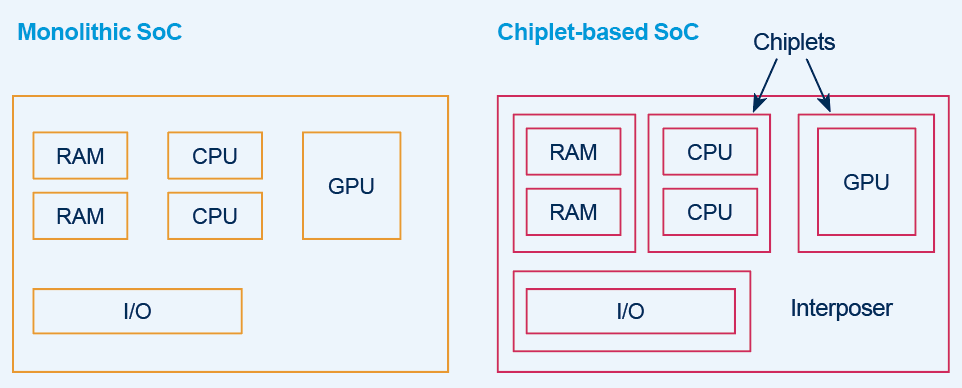Chiplets: providing commercially valuable patent protection for modular products
Many products are assembled from components manufactured and distributed separately, and it is important to consider how such products are manufactured when seeking to provide commercially valuable patent protection. This article provides an example in the field of computer chip manufacture.
Chiplets
A system-on-a-chip (SoC) is a type of integrated circuit product which acts as an entire computer in a single package, providing low-power and high performance data processing. SoCs are widely used, and provide the brains of smartphones, leading edge laptops, IoT devices, and much more.
A SoC includes essential functionality such as a central processing unit (CPU), memory, input/output circuitry, and so on. A traditional SoC provides these functions within a single monolithic piece of semiconductor material (for example, silicon) manufactured and distributed as a single integral device.
An emerging technology is the manufacture of a chiplet-based SoC by assembling a number of separately manufactured microchips known as ”chiplets” together in a package. Each chiplet is a building block having some functionality, and the collection of chiplets together provides the functionality of the SoC.
A chiplet-based SoC can have various advantages over monolithic SoCs, including increased production yield due to testing of individual chiplets, increased design flexibility as chiplets can be made using different manufacturing processes, and allowing simplified SoC design by assembling off-the-shelf chiplets.

The law
In the UK, direct infringement under s.60(1) UK Patents Act requires that an infringing product includes every feature claimed in a patent claim.
This is fairly straightforward when considering infringement by an integral device such as a monolithic SoC: anyone making, importing, or selling a monolithic SoC including the claimed invention infringes the patent. For a monolithic SoC it doesn’t matter which parts of the SoC perform the different parts of the invention: the SoC is manufactured in one go and therefore an infringing SoC includes all of the claimed features from the point of manufacture.
However, due to the introduction of chiplets, a SoC is also an example of a product which may be assembled from separately manufactured parts. When patenting inventions in SoCs, such as developments at an architectural or micro-architectural level or techniques which might be implemented using a SoC, it may be natural to claim features of the SoC as a whole based on an assumption that a monolithic SoC would be used. However, this might lead to difficulties enforcing the patent.
In particular, a patent claim for an invention implemented in a chiplet-based SoC might include features provided by different chiplets, meaning that no chiplet alone provides all of the features of the invention. Therefore, manufacturers (or importers or sellers) of individual chiplets might not directly infringe the patent. The patent might only be directly infringed when the chiplets are finally assembled into a SoC, and this can diminish the commercial value of the patent as large parts of the supply chain are unprotected.
Indirect infringement under s.60(2) UK Patents Act might provide a get-out in some cases where a chiplet could be considered to indirectly infringe a patent for a SoC even if the chiplet does not include all the claimed features. However, it is often much harder to prove that indirect infringement has occurred, especially in cases of cross-border sale between a manufacturer in one territory and a downstream party in another territory.
Practical advice
It is important that an attempt is made to draft claims so they are directly infringed by products which are manufactured and distributed together. In the field of computer chip manufacture, claims should attempt to cover individual chiplets rather than full SoCs.
Often the core concept of an invention is actually provided by features of a particular sub-component, such as a particular chiplet. A careful selection of claim features can limit the claims to that particular component, so manufacture and sale of the component alone directly infringes the claim. If other elements are important to provide context for the inventive concept, it may be sufficient to refer to those elements indirectly in the claims so that they are not required for infringement.
It is worth noting that, as demonstrated by the introduction of chiplets changing the way SoCs are manufactured, what might be considered an integral product is liable to change as technology develops. We therefore recommend seeking professional advice from a patent attorney familiar with the technical field of your invention.


